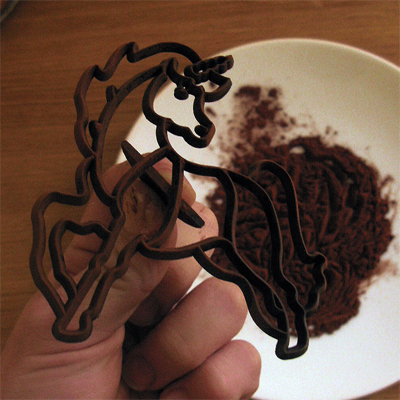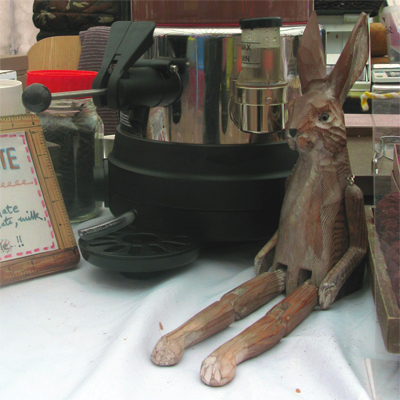Baked cheesecake with embossed pattern
(with step-by-step with pictures)
.
 (…with unicorn pattern embossed)
(…with unicorn pattern embossed)
.
 (It is ultra c ♥ r ♥ e ♥ a ♥ m ♥ y & the texture is melt-in-your mouth like a soufflé!)
(It is ultra c ♥ r ♥ e ♥ a ♥ m ♥ y & the texture is melt-in-your mouth like a soufflé!)
.
x . x x . x x . x x . x x . x x . x x . x x . x x . x x . x x . x x . x x .
.
This must be one of the most easiest of cake recipes!
- It doesn’t involve separating eggs.
- Nor whisking any time-delicate meringues, so you can take as much time leisurely making it.
- There’s minimal washing-up to do too, as all the mixing happens in one bowl.
- As for the biscuit base, you can further avoid washing-up by simply massaging the store-bought biscuits & butter in a food bag! Of course you can do it the usual way by using bare hands, but do it my way, you’d also avoid getting unpleasant biscuit-mash in your nails & your fingers buttery.^^ On that same note, I also suggest cling-filming the 3 middle fingers when pressing down the biscuit to the base.
- There is no adventurous water-bath method to contend! (Some cheesecake recipes use the water-bath method to cook it gently so that it doesn’t crack, but I for one have a long hate-relationship with the method ever since the water seeped in to my cakes via the removable bottom in many occasions in the past…)
.
The texture of the cheesecake is creeeeeamy! I managed this by tweaking the balance of the ingredients so that it uses tons of double cream/ sour cream/ cream cheese, but as little as possible of flour (… flour creates the ‘structural pillar’ that holds the cake in the inflated spongier shape – please read my blog-entry on flour for explanation of this).
.
I sell my cheesecakes down at the market. And I’m happy to say that it’s been a hit no problem. It’ll always definitely be in my line-up because it has acquired a bit of a following ^^
– Like the lady who said: “I used to buy your flour-less chocolate cake all the time, but now I converted to always buying the cheesecake!” And the spectacled-man who’d get disappointed if it’s sold-out. There’s also my favorite tomato-seller girl who’ve been buying the whole cake for 4 weeks in a row, but says she never gets to eat as much as she’d like to because her boyfriend & her family loves it too!
.
The pattern:
When I first started selling the cheesecake, it had no pattern on top. Although I was perfectly confident with the taste, I felt the presentation needed ‘Something’. Y’know, that ‘Something special’ for the wow factor & for the customer to justify their purchase. For a long while I was thinking of a solution to this; & I was enquiring around to see if I could get an iron stamp that I could heat & emboss/ burn a pattern with. But, one, it is difficult to get hold of, & secondly it’s never in a pretty pattern!
– So next I thought what about stenciling with cocoa powder? But maybe not. It’ll be too smudgy…
– Then it occurred to me while I was embossing my chocolate bird tart. Ah! Just invert it! Cocoa powder & cookie cutter! Simply dab cocoa powder on the blunt end of the cookie cutter, then tap off the excess & stamp the cake!
.
 (I get asked A LOT at the market on how I do it!)
(I get asked A LOT at the market on how I do it!)
 (My favorite stamp! – I love unicorns…)
(My favorite stamp! – I love unicorns…)
.
Note:
- I mixed together oat biscuits to the plain digestives to add interest in flavour. It also gives you a different sort of crunch compared to the pap the digestives can become.
- Resting the pressed biscuit base in the refrigerator while you make the filling firms the butter within.
- Sour cream tenderizes the cake, as well as enhancing the tang of the cream cheese.
- Excessively tapping away the air bubbles is the key to avoiding cracks on the surface that is the oh-so-common pitfall of baking a cheesecake.
- Lining the sides of the pan with baking paper also helps to avoid cracked surface. The common problem with the cheesecake is that it tends to stick to the side of the pan, but as it cools it tries to pull away from the wall. This tension ends up with a cracked surface. Whereas if you line it with baking paper, the paper will agreeably pull away with the cake too…
- The only down-side about this cake (if there is one) is that you have to keep your mitts off & leave it to mature over-night!
.
So here it is! (Finally!) My baked cheesecake recipe.
.
x . x x . x x . x x . x x . x x . x x . x x . x x . x x . x x . x x . x x .
.
The Baked Cheesecake Recipe:
.
Ingredients:
For the biscuit base:
- 70g Oat biscuits
(…Obviously it depends on brands, but for me it was 4 ½ biscuits)
- 85g Digestive biscuits
(…Obviously it depends on brands, but for me it was 5 ½ biscuits)
- 70g unsalted butter
.
For the filling:
- 70g unsalted butter
- 90g castor sugar
- 330g cream cheese
- 90 ml sour cream
- 100g whole eggs (approximately 2 eggs)
- 100 ml double cream
- 25g flour
- 12 ml lemon juice
.
x . x x . x x . x x . x x . x x . x x . x x . x x . x x . x x . x x . x x .
.
Method:
- 1. First begin by greasing a 8″ round spring-form cake pan with butter. Then line both the base & the sides with greaseproof baking paper.
- 2. Now on to making the biscuit base. First measure your biscuits (70 grams Oat biscuits + 85 grams Digestive) in a food bag.
- 3. Crush them by hand or bash it with wooden rolling pin. Leave some chunky for interesting texture.
- 4. Melt 70 grams of butter. Put it in the food bag.
- 5. Massage the food bag to combine.
- 6. Empty the mixture in a greased & lined pan.
- 7. Press the biscuit mixture firmly to the base. I like to do the edges & work to the middle. (Optional: cling-film the three middle fingers for hygiene & to avoid buttery fingers!)
- 8. Refrigerate the pressed biscuit base while you make the filling.
- 9. Preheat the oven to 170 degrees centigrade.
- 10. Next, in a mixing bowl whisk the 70 grams of butter until very soft & creamy.
- 11. Add in the 90 grams of sugar. Whisk & combine.
- 12. Add 330 grams of cream cheese. Whisk & combine.
- 13. Add 90ml of sour cream. Whisk & combine.
- 14. Add 100 grams of whole eggs. Whisk & combine.
- 15. Add 100ml double cream. Whisk & combine.
- 16. Add 25 grams of flour. Whisk & combine.
- 17. Add 12ml Lemon juice. Whisk & combine.
- 18. TAP the bowl MULTIPLE times on the work surface to let the air bubble out. (take your time doing this as this is the key to avoiding cracked surface!)
- 19. Slowly pour the mix in to the cake pan. Tap it some more on the work surface.
- 20. Place the pan on top of a baking tray, & pop it in the oven. (You need the baking tray to collect the small amount of butter that seeps out from the bottom of the cake pan)
- 21. Bake for 30 minutes first.
- 22. Have a look. If it looks like it is starting to brown too much on top, cover loosely with foil.
- 23. Bake for another 10 minutes.
- 24. Skewer test. I like it when it isn’t thoroughly cooked. (But obviously not raw!) If there’s a tiny bit of curdle on the skewer still, it’s fine, take it out.
- 25. Leave aside – still in the cake tin – overnight to mature.






 (Picture of cherry clafoutis, the wine poached pear & chocolate tart & pear tart – picture taken back in Summer 2006)
(Picture of cherry clafoutis, the wine poached pear & chocolate tart & pear tart – picture taken back in Summer 2006) (Cherry clafoutis, 8 inch’er – Picture taken back in Summer 2006)
(Cherry clafoutis, 8 inch’er – Picture taken back in Summer 2006)







